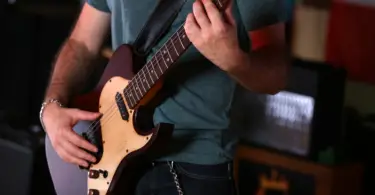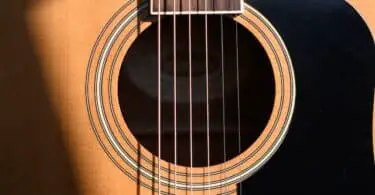A guitar riff is basically a cluster or sequence of notes or chords incorporated into a song, providing a rhythmic theme and giving the listeners a catchy and memorable tune. It is also like the lifeblood of music genres like Rock, Blues, Heavy Metal, and Punk.
You can play a guitar riff repeatedly as you wish or play it during a guitar solo once. Aside from that, guitarists also use it as a song’s basis or work as a minor decorative element.
If you’re interested in learning to write a riff, you need originality, creativity, and a little bit of technical understanding. But don’t worry, any musician can master a guitar riff.
Quick Links
Repetition
To better understand guitar riffs, you have to learn its three main components, including repetition. As you may have observed in most songs, guitar riffs are not meant to play only once.
Guitar riffs are usually played in the intro of a song and other parts. But, you can also work as an interlude.
Its role is more than just being repeated over and over again. In fact, some guitarists make it even more refreshing to listen to by changing some of its notes.
Beginners might find it challenging to play guitar riffs. So, if you want to upgrade your guitar riffing skills, train your fingers using riff bands.
Rhythmic
Guitar riffs are like playing rhythm. In a song, it works like a rhythmic basis while the other instruments or singers are giving the main melody.
The Musical Composition’s Base
Guitar riff stands as the song’s base in music genres like Rock, Heavy Metal, Punk, and Blues. It gives rhythm and melodic elements to the song at the same time.
If you’re an advanced guitar player, you might want to create a guitar riff of your own.
Here is how you can do so:

How To Write A Riff
1. Know What Sort Of Guitar Riff You Wish To Write
The first step to writing a good guitar riff is to determine the musical goals you have and determine the kind of riff you wish to create. For instance, you want to make a heavy, thrashing metal riff, or you are a member of a melodic rock band.
But if you are into musical styles, your guitar riff should be diverse and often overlapping. If this is your case, never be afraid to get totally creative and original.
A guitar riff can nearly be everything. One perfect example is the memorable metal and rock riffs of all time, the song “Sweet Child of Mine” by the band Guns ‘n’ Roses, which is a song that is simply repeating a single bar.
Guitar riffs can also elaborate runs that last for four bars or more like the “Highway to Hell” by AC/DC or Megadeth’s “She-Wolf.” So, don’t limit yourself when composing a rock guitar riff.
2. Get Inspiration From Your Favorite Riffs
One of the best ways to write your guitar riff is to get inspiration from the existing ones. Take note of the riffs that stand out to you the most, their sound, rhythm, and composition. Doing this can help you to come up with a beautiful-sounding guitar riff.
You may listen to different guitarists and learn their approach to writing riffs. Try listening to Black Sabbath, a band known for their riffs’ catchiness and structural strength that incorporate simple methodologies with their distinctive writing styles.
3. Determine The Sound You Want
Before you begin the writing process of your riff, it is best to get an idea of what type of sound you are opting for. This will allow you to use the right playing methods and tuning.
First, determine whether your desired sound is playful or heavy, slow and grinding or uptempo, chugging or melodious. You may also get creative by coming up with a riff that will sound in a style you usually don’t choose.
4. Write The Riff
Play the riff musically inside your head, hum it out loud, or play it on your guitar until you come up with something you can write. By doing so, you will be able to take note of the sound that can lead you to the riff you can finally call your own.
Afterward, work on the riff’s details and hear how it sounds. This will allow you to know what guitar tone will work better for playing the whole riff.
Also, make some minor adjustments as necessary until your riff becomes complete.
5. Play Around With The Riff
Now is the time to practice your guitar riff. Grab your guitar and test it. Start by playing around with the basic melody you came up with to complete the foundation for the riff’s notes.
Also, capture the sound you thought about faithfully in your head. It is because listening to its sound out loud will allow you to get a better view of what should be removed or added to your riff.
Try including stylistic embellishments like palm-muting, hammer-ons, and pinch harmonics when you find your riff lifeless. These styles are usually incorporated in metal songwriting as well as used in adding depth to a bland riff.
Aside from that, it’s also a good idea to improvise a little, just like what jazz musicians do around a theme. Play your riff four to five repetitions while making slight departures from your choice of notes’ sequence each time. This might help you end up with a riff that sounds more original and suits your taste better.
6. Select The Right Riff Structure
Customize your guitar riff to be measured in a specific number of bars, a time segment correlated with a certain number of beats. Try using varying speeds when playing the bars or make slight changes to the riff’s final bar to discover new rhythmic structures and provide a rounded sound to a riff.
Most of the old riffs inspired by rock are played in a “3+1” bar structure. In this structure, one bar is repeated three times, and a minor change on the last bar is made to come up with a total of four bars.
Due to its general application, this bar structure is considered an ideal starting point for guitarists who don’t know where to begin.
7. Get Technical
If you know the basics of writing tablature, you won’t have any problem writing down your riff. It will allow you to see your riff clearly, visualize it, arrange it easily, and memorize it.
Also, it will help if you take note of anything about tuning or progression to improve your riff. But for those who don’t have any idea about writing tabs, it is not too late to learn this skill.
In fact, the basics of tablature are easy to learn. It is also necessary to learn the basics if you want to start writing more complex music pieces in the future.
8. Refine Your Sound
Now it’s time for the finishing touches. Listen to your completed riff and determine if it matches your original idea.
You can omit or change parts that don’t sound right to you to get the results you are opting for. Since music is an art, never consider your riff as complete until it becomes perfect.

Skills You Need To Play Guitar Riffs
Below are some of the skills you will need to play guitar riffs:
- Legato
- String Skipping
- Timing
- Feel
- Left And Right-hand Coordination
- Others
- Alternate Picking
With the skills mentioned above and dedication, you will learn how to play riffs in no time. If you are eager to play riffs, start honing your riffing skills by practicing “Sweet Child o’ Mine” and “Black In Black” today.
What Makes A Guitar Riff Heavy?
You can observe that some guitar riffs sound heavy. A strong groove or rhythm, along with an excellent guitar tone, makes a guitar riff heavy.
Also, riffs that centralize on a strong rhythm while having the right notes or chords give off a heavy feeling. Among the common misconceptions about such riffs is that the guitarist has to lower their guitar’s tuning to play heavy riffs.
Aside from that, people also thought that guitars that are low-tuned would allow you to come up with heavy riffs. But they don’t, as guitars with low tuning don’t make guitar riffs sound heavy.
Many heavy riffs are played in standard tuning. Also, some guitar riffs played on an 8 string guitar don’t sound heavy at all. Write a riff that centralizes on a strong groove or rhythm if you wish to write heavy guitar riffs.

Some Final Words
Generally, guitar riffs are interesting, and they bring forth rhythm to a song as well as keep them sound interesting when the guitarist alters some notes to the riff when needed.
You can easily attract attention by playing guitar riffs as it can make a song memorable. So, if you want to master writing and playing riffs, try the steps mentioned earlier. You should also be eager enough to learn the basics of writing tablature to organize your riff and be committed to practicing your riff.






